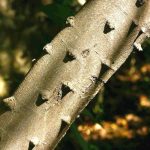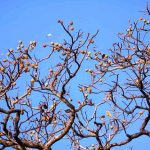TREE LIFE
May 1986
HARARE CALENDAR
Tuesday May 6th : Botanic Garden walk. Meet in the Car Park at 1645 for 1700 hours. Please note we have not switched to the first Saturday morning this month as it would clash with the Bulawayo trip.
1st – 4th May : Matopos / Bulawayo trip. See Tree Life 73
Snday May 18th : Mwengi Dam. The vegetation below the dam wall has obviously been well preserved. The trees are large and include Antidesma venosum, tasselberry, Afzelia quanzensis, Pod Mahogany and Ekebergia capensis – just to whet your appetite. A bus has been arranged which leave from Monomatapa Car Park at 0830 hour. A security guard will look after the cars. The fare is $8.00.
MATABELELAND CALENDAR
Our May meeting will be on Friday 2nd May at 0900 hours at Maleme Rest Camp in the Matopos to visit interesting tree areas, and we look forward to meeting our Harare visitors there. On Saturday 3rd May the meeting place will be Retreat Shopping Centre at 0915 hours, or alternatively at Falls Road Motors at 0945 for a visit to the Kalahari sandveld area at Pasipas, followed by a look at the Baikiaea plurijuga growing at the edge of Aisleby Sewage Farm, we also have water birds for any birders amongst us.
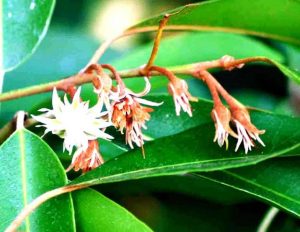
Mimusops zeyheri. Photo: Bart Wursten. Source: Flora of Zimbabwe
Our April meeting was in the area between Burnside and Circular Drive which consists of a dry stream bed surrounded by grassland, with several interesting kopjes dotted around. We concentrated on these well wooded outcrops and found about 50 species, among them Acacia karroo, A.sieberana and A.rehmanniana, the latter still flowering; Albizia amara and A.antunesiana, which was in the same area as Burkea africana, but the Burkea still had fruit hanging. On top of the hills were Diplorhynchus condylocarpon, Ficus ingens, F.glumosa and F.sur, capensis, Mimusops zeyheri, Pterocarpus angolensis and Schrebera alata with a great variety of colour and size of leaves on different trees. Some confusion was caused by Melia azedarach and Kirkia acuminata growing together, both being described as “white syringa”.
-Betty Blake
BOTANIC GARDEN WALK 1ST APRIL 1986
This was led by Kim Damstra and concentrated on some of the Zambezi valley species which could be expected to be encountered on the Mana Pools excursion and Kim intended to write u the two in the same article. The postponement of the Mana trip as a result of the recent rains means that we will have to wait till the next issue at least.
MPONDAMINA ON THE DYKE : SUNDAY APRIL 20TH 1986
Of the 36 people who arrived at the Monomatapa Car Park for the 0830 hours start, not one suggested that we cancel the trip because of the inclement weather. We left in the rain and we returned in the rain and it rained during the day, but as there were no complaints, I am sure everyone enjoyed the day as much as I did.
It was dry when we arrived at Mpondaminga.
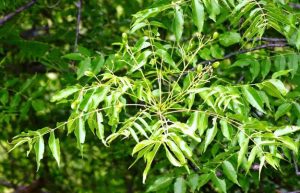
Kirkia acuminata. Photo: Bart Wursten. Source: Flora of Zimbabwe
While the queue for the loo diminished, we wandered around the garden admiring the trees, the view and the aloes and tried to imagine what they would look like in flower and whether their names and the pronunciation thereof were really important. There were a couple of Hymenodictyon floribundum, the Firebush, in magnificent red leaf. This is the time of year when they turn red and drop their leaves in a short space of time and so we were there just at the right time. We also saw Kirkia acuminata which gave Phil the appropriate moment to welcome the members of the Kirk Society to the outing. This is a Society of budding botanists at the University. We wondered when the name Kirk. Sir John Kirk, GCMG, KCB,FRS,MD to give him his full title, was born near Dundee in 1832 and as one of the principal hobbies of his father was botany, his interest in plants must have developed at an early age. This continued and while he was a student he became a fellow of the Edinburgh Botanical Society. He graduated as a medical doctor in 1854 and in 1855 as such sailed for Crimea. While there, first at Scutori and later in the Dardanelles he found time off from his medicine to collect plants on Mt. Olympus and Mt. Ida. He was appointed as Naturalist to Livingstone’s Second Expedition of which he was a member for 5 years. They left England on March 10th 1858. His diaries consisted of 10 note books filled with careful pencil written notes and sketches and his collection of plants was extensive. In March 1860 one member of the expedition returned to Britain with four case of Kirk’s specimens consigned to Sir William Hooker. In 1883 his son, Sir Joseph Hooker who had succeeded his father as Director of Kew received a letter from Portsmouth Dock saying that 4 cases of specimens had been deposited there in 1870 and please would he take steps to have them removed. What happened between 1860 and 1870 only the cases know.
In November 1860 when shooting the rapids at Kebrabasa, Kirk’s canoe was dashed against the rocks and he lost many of his specimens, 8 volumes of notes and all his equipment. The specimens which he had collected at the Victoria Falls were fortunately in another canoe. Kirk left the expedition in May 1863 and returned to London. At Kew he deposited a large collection of plant specimens accompanied by a valuable collection of field drawings from the Zambezi Valley; an area which at that time was rich in undescribed species; he was also one of the earliest photographers and amongst the first to photograph the vegetation of the Zambezi region.
I thought it would be interesting to recall some of the plants which have been named after John Kirk. The genus Kirkia was described in the Flora of Tropical Africa by Oliver in 1868 and so was Kirkia acuminata, both from specimens collected by Kirk at Kupata and Sene in Mozambique probably in October/November 1858. Another species described by Oliver, this time 1871 is Acacia kirkii, flood plain Acacia, a species of the Zambezi Valley and having pods with a wart like protuberance over each seed. This was collected by Kirk in the Batoka country in the Southern Province in 1860.
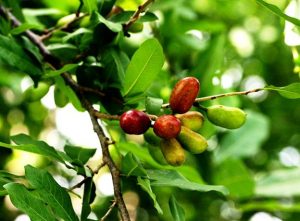
Cleistochlamys kirkii. Photo: Bart Wursten. Source: Flora of Zimbabwe
Cleistochlamys kirkii a member of the ANNONACEAE family is a lowveld species and was originally called Popwia kirkii by Bentham in 1862; however Oliver in 1865 decided that it belonged to the genus Cleistochlamys. Kirk had collected the material from Mozambique opposite Sena at the foot of Mt. Murrombala.
Type specimens of Maerua kirkii, large flowered Maurua are from Cape Mclear on Lake Malawi and Mitonda on the Upper Shire River and were collected by Kirk in 1861. This was originally called Capparis kirkii in 1868 by Oliver and updated by F. White in 1958.
In 1877 Spencer Moore of the British Museum described Ormocarpus kirkii, the Caterpillar pod with which we are all familiar and the type specimen came from the River Tola in the Somali Republic. Some other “kirkii’s” which Kirk collected are Psychotria kirkii the fairly widespread shrub often seen in granite in the watershed woodlands; Rhus kirkii a suffrutex mainly found in open Brachystegia woodlands, but discovered by Kirk near the Victoria Falls; Dombeya kirkii, River Dombeya growing at lower altitudes was first collected by Kirk at the Lupata Gorge on the Zambezi River; at Cabora Bassa, spelt Kebrabassa, in his records, about 1860, Diospyros kirkii was collected and described by Hiern in 1873. All those have maintained their names as being the earliest collected and described.
Kirk collected a Cussonia at Mt. Morrumbala which was named Cussonia kirkii. Unfortunately, it was subsequently discovered that the species had been described earlier and named Carborea. This of course is our familiar Octopus Cabbage tree. And the most recent casualty is Ficus kirkii a giant strangler of evergreen forests which gives way to the name F.scassellattii.
Kirk subsequently spent 20 years in Zanzibar as a medical doctor, Vice Consul and the Consul General and is famous for the part he played in suppressing the slave trade and was knighted in 1890. He retired to England and died in 1922.
As a footnote, “Kirkia” the Journal of Botany of Zimbabwe, together with Flora Zambesiaca have been my sources of information.
-Phil Haxen
We had a good day with lots of interesting species. Olax obtusifolia was there, but Kim was not and so we had no one to persuade us that when the leaf was crushed and the cells broken cyanide was released into the air. Ficus nigro-punctata was an exciting find. When we last saw this species at “Kujawy”, Gadzema, it was growing in the fork of a tree and the roots had not yet reached the ground. Then it was suggested that as this was such a rare tree, many of us were unlikely to see it again. Punctata comes from the latin punctum, point, and to quote from the dictionary of Scientific Terms, means, “dotted” having a surface covered with small holes or dots; having a dot like appearance.” Returning to the write up of the specimen we saw at Gadzema, Kim said that the trunk was not black, nigro, although the trunk of this tree, other than that it was about 10cm in diameter and was growing next to and strangling a Vitex payos. However, we did look for black dots in the leaves and through a lens we could see little dots all over, although these dots were not black. The leaves put in a plastic bag, identified at the Herbarium and now being looked at again, still have little dots when held against the light and examined with a lens, but the upper surface of the leaves have now become black, perhaps that explains the name and we could translate nigro-punctata as “leaves which turn black and are covered with little dots”?
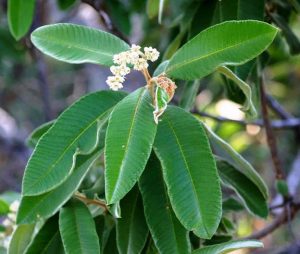
Ozoroa insignis. Photo: Bart Wursten. Source: Flora of Zimbabwe
We then looked at Ozoroa insignis, Tarberry and Raisinberry. This tree was fruiting and we were able to see the kidney shaped fruit covered with black wrinkled skin and looking for all the world like a raisin or currant. Tasting it offered nothing in the way of nourishment and little in the way of flavor. In fact it left the mouth slightly dry. We then climbed through the fence and came face to face with a Combretum zeyheri, large fruited Combretum with unmistakably large green shiny fruit and interesting galls 3-4mm wide, 30-40mm long about 20 in all along a little stalk.
We then moved to Ozoroa longepetiolata with as the name suggests, long petioles. The drooping foliage is silvery grey and the stems cinnamon coloured, giving the tree a willow like appearance. These trees only grow along the chrome hills of the Dyke and so are of great interest. The first one we looked at was in fruit, more round than kidney shaped, but with the same wrinkled skin and disappointing flavor.
With quite a pleasant flavor, if one was fortunate enough to discover a ripe one, was the fruit of Rhoicissus ravoilii. This is a member of the grape family VITACEAE, and had a trunk and branches very strongly resembling a grapevine. The leaves are trifoliolate and the under surface covered with dense rusty hairs which are quite beautiful when caught in the right light.
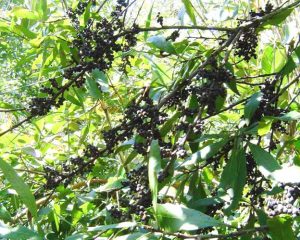
Myrica serrata. Photo: Bart Wursten. Source: Flora of Zimbabwe
Eventually we reached the river where we saw Diospyros natalensis, its tiny leaves festooned with the debris of a recent flood. A Myrica serrata was climbed in order to acquire leaves for identification. This is known as the Waxberry and the fruit and branches immersed in boiling water give off a true fat, rich in fatty acids. The leaves are alternate and serrated. The serration or scallops round the margin are somewhat reminiscent of Nuxia oppositifolia which we also found. As the name suggests, that has opposite leaves.
By this time the rain was threatening and the sensible made their way up to the house. The less sensible lingered a little too long and got wet. However, I must mention that the presence of Rappanea melanopheous has been confirmed.
We had lunch on the verandah, in the house and in the bus, while the rain teemed down. It was well after 1400 hours when it eventually eased off and we boarded the bus and went off to explore the small patch of Swamp Forest which was supposed to have been used in the filming of King Solomon’s Mines. This may well have accounted for the excellent state of the road to that spot.
The forest consisted of big trees which we easily identified as Syzygium and which I am assured is S.quineense, although they had long narrow leaves and a small petiole. This is the form that S.quineense takes when in swamp forest conditions and the possibility of it being a hybrid with S.cordatum has not been ruled out. Of the 14 leaves on the twig I brought back one appeared to have a tendency to exhibit a slight cordate base, and many more leaves should have been examined. Other species in the forest were Maesa lanceolata, Nuxia oppositifolia and Phoenix reclinata.
We returned via the Mtoroshanga Pass and stopped to look, through binoculars, I might add, at Aloe ortholopha and Euphorbia wildii both of which are also endemic to the Dyke.
Thanks to the Perry family for allowing us to invade their hose and for sharing the trees with us.
-Meg Coates Palgrave
CHEGUTU NOTES – BRUNSWICK FARM 6TH APRIL 1986
The Chegutu group met at Brunswick Farm on 6th April and a surprisingly rich venue it proved to be. Our host, Neville Sparks took us to a belt of woodland running across the farm, left by him as the soils there are gravelly and shallow, but clearly fertile enough for trees. And as soon as we started our walk we met with a puzzle, a Combretum with large leaves and rather large reddish 4 winged fruit, then Meg found the hall mark of C.zeyheri, the odd set of 3 whorled leaves, but it has since been identified as C.collinum. Later we were to see a number of C.zeyheri with the more typical large light green to yellow fruit, and C.hereroense, the mouse eared Combretum with its small fruit already turning the rich chocolate shade, that makes the tree so conspicuous; C.molle with its rather large, hairier leaves, C.imberbe with smaller grey green leaves, the leadwood that provides termite proof fencing posts. Not far off were a Gardenia volkensii with its fresh green rather spatulate leaves in whorls of three, grey smoothish bark and its hard fruit just showing the grayish encrustations. Entwined amongst it and a Berchemia discolor were Margaritiria discoides with its rather shiny leaves, and ‘lizard legs’ twigs (Cheryl’s apt memory reviving phrase), and the ever present Dichrostachys cinerea, its pods still green and rather cankerous looking, thickets of this abounded. Then excitement, a tree with smaller combretum like leaves and noticeable leaf buds in the axils, the finding o a few old 4 winged seeds settled it for us, Pteleopsis anisoptera, which we have seen along the banks of the Mupfure river and on thistle Farm, so should have remembered. But what specimens these were here on Brunswick many with trunks of 50cm in diameter and tall withal, a real surprise and pleasure to see. And yes, they are combretaceous.
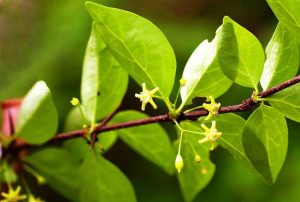
Canthium frangula. Photo: Bart Wursten. Source: Flora of Zimbabwe
Not far away, a small anthill offered a close look at Markhamia acuminata with compound leaves somewhat rough to touch, and growing in a coppice as it frequently does; Ehretia obtusifolia which we were to see again on anthills, and another large Gardenia across the road Lonchocarpus capassa with smoothish creamy grey bark, and compound leaves with the large terminal leaflet. Dalbergia melanoxylon of fair size also flourished, and we saw Canthium lactescens of a good size tht exuded a whitish liquid when snapped to show the derivation of the name. Not far off Canthium frangula with its opposite, decussate leaves and spines looking so different that non botanists puzzle over the classification, and wonder why we do not use it as a deterrent hedging! Capparis tomentosa carried dried fruits that help identification, but its modified stipules providing the leaves with a thorny guard are another deterrent. And then more excitement, small specimens of Zanthoxylum chalybeum led us to an anthill with a large example, we crushed the leaves to enjoy the citrus oil scent and held them to the light to see the glands that produce it, having due regard for the prickles along the back of the petiole and rachis. And then Manilkara mochisia that we last saw at Lawrence’s kopje and Thistle Farm with its leaves in terminal rosettes, deceptively like the smaller leaved figs from a distance. Both Lanneas we saw, the L.discolor that is perhaps more familiar and L.schweinfurthii var. stuhlmanii with compound leaves that may remind one of the Marula or the Commipora mossambicensis, which we also saw. On another anthill we saw a particularly large Zanthoxylum ch. With a particularly fine Berchemia and all wondered if the plants arrived after the anthill, and Meg offered a theory that the moisture content of the soil. Both Ximenias X.americana and X.caffra were seen with some fruit ripening, as was Flacourtia indica and Allophylus africanus and Rhus tenuinervis, how helpful it is to see the fruit on these latter plants.
Heading over towards a good sized Euphorbia ingens we came across another tree, new to many of us which Meg felt was Xergroderris stuhlmanii, we shall have to look at the one on Maradadi again someday. Near another anthill we found a sapling that puzzled us, and which has since been identified as Vitex mombassae, in its 3 foliolate form. We shall have to look out for this one again, its an unusual finding. The Diospyros family were seen, D.mespiliformis which can be really large, often on anthills in the Chegutu area, D.kirkii with its rounder leaves and often twisted shaped look and D.lycioides, a favourite browse for game in hard times. Two more Combretums, C.fragrans and possibly C.psidoides, completed our list for that family. Of the Acacias, A.karroo and A.rehmanniana were the only ones we had time to look at properly. Indeed the list is far from complete but our minds were saturated and the sun hot, so we headed back for the Spark’s shady garden and welcome refreshment. A rewarding venue and a lesson not to be influenced by outward appearances. Our thanks to Neville and Irene for hosting the meeting, you may see us again!
Next meeting – 4th May and the Speights have invited us to their farm, Ezintabeni on Lowood road off the road to Chinhoyi
June meeting, Crsky Farm, Gadzema, our hosts Mike and Angela Campbell.
-Anne Bianchi
Kim Damstra Chairman


